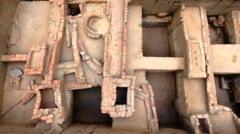In the annals of archaeological discovery, few moments rival the significance of the unearthing of Mohenjo-daro by Indian archaeologist Rakhaldas Banerjee, whose brilliance and controversies have left his legacy obscured. Operating during the early 20th century, Banerjee’s findings shed light on the expansive Indus Valley Civilization, a monumental society that spanned from present-day Afghanistan to India.
Born in Bengal in 1885, Banerjee’s fascination with history blossomed from the medieval monuments of his hometown, Baharampur. Eventually, he joined the Archaeological Survey of India (ASI) as an excavation assistant in 1910, quickly advancing to superintending archaeologist by 1917. His groundbreaking encounter with the ruins of Mohenjo-daro in 1919 marked the start of a series of excavations that revealed the ancient city’s sophisticated urban planning and cultural wealth, showcasing relics like seals, coins, and pottery that highlighted the civilization’s grandeur.
However, Banerjee's brilliance was often accompanied by a tempestuous quest against colonial norms. His penchant for defiance placed him in numerous disputes within the ASI. According to historian Nayanjot Lahiri, his independent actions, such as attempting to procure resources without proper authorization, led to disconnects with superiors and tarnished his image in the archaeological community. As a result, while John Marshall, the ASI chief, received accolades for the discovery, Banerjee was left as merely a footnote in history.
Despite his pivotal role, Banerjee's reports on Mohenjo-daro were never published—further allowing his contributions to fade into obscurity. Financial disputes and allegations of misconduct marred his latter years, leading to a forced resignation following accusations regarding idol theft. Although these charges were dismissed, they cemented a tarnished reputation that impacted his professional trajectory.
Even after leaving ASI, Banerjee's life remained turbulent, marked by financial strain despite a professorship at Banaras Hindu University. Tragically, he passed away in 1930 at just 45 years old, having left an indelible mark on archaeology but remaining largely unrecognized in popular historical narratives.
As scholars continue to re-evaluate the complexities of Banerjee's life and work, it is an opportunity to illuminate the contributions of those who have been forgotten yet played vital roles in preserving our understanding of ancient civilizations and cultural heritage. The exploration of Mohenjo-daro undoubtedly stands as one of the great achievements of human history, but recognition of Rakhaldas Banerjee’s contributions may finally allow his legacy to reclaim its rightful place within the chronicles of archaeological discovery.





















